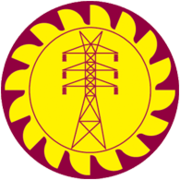|
Ceylon Electricity Board
The Ceylon Electricity Board - CEB (Sinhala: ලංකා විදුලිබල මණ්ඩලය - ලංවිම, romanized: Lankā Vidulibala Mandalaya - Lanwima; Tamil: இலங்கை மின்சார சபை - இமிச), was the largest electricity company in Sri Lanka. With a market share of nearly 100%, it controlled all major functions of electricity generation, transmission, distribution and retailing in Sri Lanka. It was one of the only two on-grid electricity companies in the country; the other being Lanka Electricity Company (LECO). The company earned approximately Rs 204.7 billion in 2014, with a total of nearly 5.42 million consumer accounts. It was a government-owned and controlled utility of Sri Lanka that took care of the general energy facilities of the island. The Ministry of Power and Energy was the responsible ministry above the CEB. Ceylon Electricity Board (CEB), established by the CEB Act No. 17 of 1969, was under the legal obligation to develop and maintain an efficient, coordinated and economical system of electricity supply in accordance with any licenses issued. The CEB was dissolved and replaced by 12 successor entities under the 2024 Electricity Act.[5][6][7]
SubsidiariesCEB has following subsidiaries[8]
Electricity GenerationHydro powerElectricity generation by CEB is primarily done by hydropower. Hydropower is the oldest and most dependent source of electricity generation, taking a share of nearly 42% of the total available grid capacity in December 2014, and 37% of the power generated in 2014.[9] Hydropower generation facilities have been constantly under development since the introduction of the national grid but are currently declining due to the exhaustion of the resource. In 2014, then Media Spokesperson at the CEB, Senajith Dassanayake said the generation of hydropower has dropped to 37%; as a result, 60 percent of the electricity needs have to be fulfilled by thermal energy.[10] Thermal PowerThe Norocholai Coal Power Station, the only coal-fired power station in the country is owned by CEB; it was commissioned in late-2011 and finished in 2014, under loans from the Export-Import Bank of China. It added further 300 megawatts of electrical capacity to the grid.[11] The Sampur Coal Power Station, is currently under consideration in Trincomalee.[12] Coal Power DevelopmentIn 2011, the Ceylon Electricity Board opened a new coal power plant named Puttalam Lakvijaya. On 13 February 2011 it was synchronized with the system.[13] On 17 September 2014, US$1.35 billion coal-fired Norochcholai Power Station was commissioned by the Chinese President Xi Jinping on his visit to Sri Lanka. The Export-Import Bank of China provided a US$450 million loan for the first 300-megawatt unit at the power plant.[14] The power plant was officially commenced on 16 September 2014.[15] Wind Power DevelopmentCEB launched Sri Lanka's largest wind farm Thambapavani added to the national grid. The project started in 2014. Power station generate more than 100 MW.[16] ControversiesBlackouts and shutdowns
2019 electricity crisis
LossesCeylon Electricity Board has lost 25.5 billion rupees in 2011, and run up debts of 121 billion rupees with a petroleum distributor[who?] and independent power producers.[25] In 2012, the CEB lost 61.2 billion rupees and the Ceylon Petroleum Corporation which supplied fuel below cost 89.7 billion rupees. To cover up the loss, the CEB increased power tariffs on a large scale. The CEB expected to get revenues of 223 billion rupees—or 45 billion rupees more than the earlier tariff—from the price hike, but subsequently lost 33 billion rupees in 2013 on total expenses of 256 billion rupees.[26] On 16 September 2014, after officially opening a completed $1.35 billion Chinese-financed 900 MW coal power plant project, Sri Lankan President at the time, Mahinda Rajapaksa addressed the nation saying that the electricity bills of the people will be reduced by 25%.[15] The CEB stated that it will take about two weeks to come up with a process of creating electricity bills to reflect the reduction in prices.[27] Employee TaxThe CEB has been accused of Tax fraud by the Campaign for Free and Fair Elections (CaFFE), which has claimed that CEB has not deducted PAYE from its engineers and senior staff since 2010 amounting to Rs. 3465 million. CaFFE has claimed that this amount has been recovered from the consumer instead.[28] RestructuringA restructuring committee was appointed as per the approval of the Cabinet of Ministers to submit proposals to restructure the CEB within a month. Committee members consisted of former and current administrative officers of the Sri Lankan Government Service.[29] See also
References
External links
|
||||||||||||||||||||||||||||||||||||
